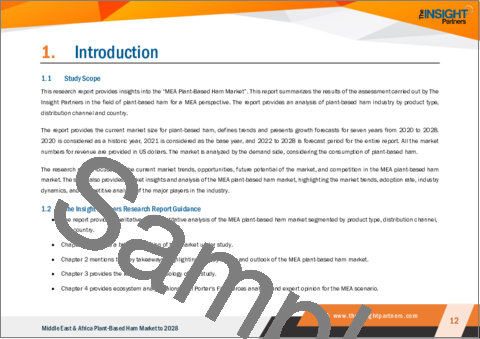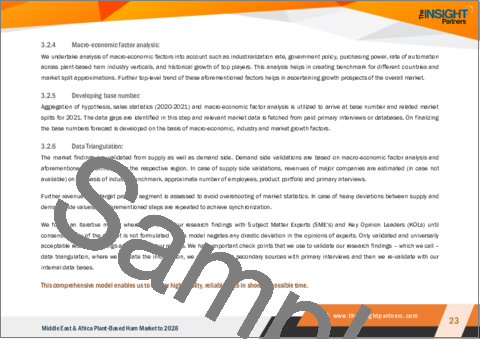|
|
市場調査レポート
商品コード
1226954
中東・アフリカの植物性ハムの2028年市場予測 - 製品タイプ別、流通チャネル別の地域分析Middle East & Africa Plant-Based Ham Market Forecast to 2028 - COVID-19 Impact and Regional Analysis - by Product Type and Distribution Channel |
||||||
| 中東・アフリカの植物性ハムの2028年市場予測 - 製品タイプ別、流通チャネル別の地域分析 |
|
出版日: 2023年02月20日
発行: The Insight Partners
ページ情報: 英文 79 Pages
納期: 即納可能
|
- 全表示
- 概要
- 図表
- 目次
中東・アフリカの植物性ハム市場は、2022年の594万米ドルから2028年には1,144万米ドルに成長すると予測されています。2022年から2028年までのCAGRは11.5%と推定されています。
新興経済諸国における需要の急増が、予測期間中、中東・アフリカの植物性ハム市場に有利な成長機会をもたらすと予想される
この地域の消費者は、持続可能で健康的な生活を送るために、肉、豚肉、牛肉の消費を減らしているため、植物性ハムはいくつかの国で大きな支持を集めています。さらに、先進国の消費者は、加工食品に使用されている製品ラベルや原材料にもっと注意を払うようになっています。植物性食品やオーガニック製品は、その健康上の利点から人気を集めています。オーガニック栽培の植物性食品は、農薬や化学肥料、遺伝子組み換え作物(GMO)を使用していないです。こうした利点が、高価格を覚悟している消費者の間で、オーガニック植物性ハムの人気に拍車をかけています。さらに、消費者は、合成香料や着色料、その他の食品添加物を含まないクリーンラベルの植物性食品を好むようになっています。また、消費者はホリスティックで意識的な消費を重視し、倫理的に調達された原材料を使用した製品を好みます。このように、クリーンラベルやオーガニックの植物性食品への需要の高まりは、予測期間中、中東・アフリカの植物性ハム市場に有利な成長機会をもたらすと期待されます。
中東・アフリカの植物性ハム市場の概要
中東・アフリカの植物性ハム市場は、南アフリカとその他中東・アフリカに区分されます。同地域では、植物性食品を好む消費者の増加により、ビーガン食品が広く普及しています。さらに、豚肉のような食感を持つコレステロールフリーのタンパク質の特典が、植物性ハムの需要を喚起しています。消費者は、代替製品の製造者が環境に対してより敬意を払い、動物福祉に貢献していることを高く評価しています。さらに、植物性製品の機能的な有効性と高い持続可能性が、中東・アフリカの植物性ハム市場を後押ししています。COVID-19のパンデミックの発生に伴い、中東では従来の動物性製品の消費に対する懸念が高まっています。2019年12月、Beyond Meatは、湾岸の主要な食品、飲料、FMCG製品の製造・販売業者の1つであるMezzan Holdingと販売契約を締結しました。Mezzanは、クウェートとUAEを皮切りに、湾岸地域全体でビヨンドミート製品の流通を担当することになります。植物性肉製品メーカーによるこうした取り組みは、今後数年間、中東・アフリカの植物性ハム市場を後押しすると思われます。
中東・アフリカの植物性ハム市場の収益と2028年までの予測(US$Million)
中東・アフリカの植物性ハム市場のセグメンテーション
中東・アフリカの植物性ハム市場は、製品タイプ、流通チャネル、国別に区分されます。
製品タイプに基づき、中東・アフリカの植物性ハム市場は、スライス・ストリップ、ロール、ローストに区分されます。2022年、ロールセグメントは中東・アフリカの植物性ハム市場で最大のシェアを記録しました。
流通チャネルに基づき、中東・アフリカの植物性ハム市場はスーパーマーケット・ハイパーマーケット、コンビニエンスストア、オンライン小売、その他に区分されます。2022年、スーパーマーケットおよびハイパーマーケット部門は、中東・アフリカの植物性ハム市場で最大のシェアを記録しました。
国に基づいて、中東・アフリカの植物性ハム市場は、南アフリカとその他中東・アフリカに二分されます。2022年には、その他中東とアフリカの植物性ハム市場で、その他中東とアフリカのセグメントがより大きなシェアを登録しました。
Hain Celestial Canada ULC、Nestle SA、Quorn Foods Ltd、およびVBites Foods Ltdは、中東・アフリカの植物性ハム市場で事業を展開している主要企業です。
目次
第1章 イントロダクション
第2章 重要なポイント
第3章 調査手法
- 調査対象範囲
- 調査手法
- データ収集
- 一次インタビュー
- 仮説の策定
- マクロ経済的要因分析
- ベースナンバーの作成
- データの三角測量
- 国別データ
第4章 中東・アフリカの植物性ハム市場情勢
- 市場概要
- ポーターのファイブフォース分析
- 供給企業の交渉力
- 買い手の交渉力
- 新規参入業者の脅威
- 競争企業間の敵対関係
- 代替品の脅威
- エコシステム分析
- 主要原材料
- 製造・加工
- パッケージング
- 専門家の見解
第5章 中東・アフリカの植物性ハム市場-主要市場力学
- 市場促進要因
- 畜産業の環境負荷と持続可能な食習慣の受容
- ベジタリアンとビーガニズムへの移行
- 市場抑制要因
- 新興国における限定的な入手可能性
- 市場機会
- 新興経済諸国における需要の高まり
- 今後の動向
- 製品革新
- 促進要因と抑制要因の影響分析
第6章 植物性ハム-中東・アフリカの市場分析
第7章 中東・アフリカの植物性ハムの市場分析-製品タイプ別
- MEAの植物性ハム市場:製品タイプ別(2021年、2028年)
- スライス・ストリップ
- ロール
- ロースト
第8章 中東・アフリカの植物性ハムの市場分析:流通チャネル別
- MEA植物性ハム市場:流通チャネル別(2021年、2028年)
- スーパーマーケット・ハイパーマーケット
- コンビニエンスストア
- オンライン小売
- その他
第9章 中東・アフリカの植物性ハム市場:国別分析
- 中東・アフリカ
- 南アフリカ
- その他中東・アフリカ
第10章 業界情勢
- 製品の発売
- コラボレーション
- パートナーシップ
第11章 企業プロファイル
- Hain Celestial Canada ULC
- VBites Foods Ltd
- Nestle SA
- Quorn Foods Ltd
第12章 付録
List Of Tables
- Table 1. MEA Plant-Based Ham Market -Revenue and Forecast to 2028 (US$ Million)
- Table 2. South Africa Plant-Based Ham Market, By Product Type - Revenue and Forecast to 2028 (US$ Million)
- Table 3. South Africa Plant-Based Ham Market, by Distribution Channel - Revenue and Forecast to 2028 (US$ Million)
- Table 4. Rest of Middle East and Africa Plant-Based Ham Market, By Product Type - Revenue and Forecast to 2028 (US$ Million)
- Table 5. Rest of Middle East and Africa Plant-Based Ham Market, by Distribution Channel - Revenue and Forecast to 2028 (US$ Million)
- Table 6. Glossary of Terms, MEA Plant-Based Ham Market
List Of Figures
- Figure 1. MEA Plant-Based Ham Market Segmentation
- Figure 2. MEA Plant-Based Ham Market Segmentation - By Country
- Figure 3. MEA Plant-Based Ham Market Overview
- Figure 4. MEA Plant-Based Ham Market, By Product Type
- Figure 5. MEA Plant-Based Ham Market, by Country
- Figure 6. Porter's Five Forces Analysis
- Figure 7. Ecosystem: MEA Plant Based Ham Market
- Figure 8. Expert Opinions
- Figure 9. MEA Plant-Based Ham Market Impact Analysis of Drivers and Restraints
- Figure 10. MEA Plant-Based Ham Market - Revenue and Forecast to 2028 (US$ Million)
- Figure 11. MEA Plant-Based Ham Market Revenue Share, By Product Type (2021 and 2028)
- Figure 12. Slices and Strips: MEA Plant-Based Ham Market - Revenue and Forecast to 2028 (US$ Mn)
- Figure 13. Rolls: MEA Plant-Based Ham Market - Revenue and Forecast to 2028 (US$ Mn)
- Figure 14. Roasts: MEA Plant-Based Ham Market - Revenue and Forecast to 2028 (US$ Mn)
- Figure 15. MEA Plant-Based Ham Market Revenue Share, By Distribution Channel (2021 and 2028)
- Figure 16. Supermarkets and Hypermarkets: MEA Plant-Based Ham Market- Revenue and Forecast to 2028 (US$ Mn)
- Figure 17. Convenience Stores: MEA Plant-Based Ham Market- Revenue and Forecast to 2028 (US$ Mn)
- Figure 18. Online Retail: MEA Plant-Based Ham Market- Revenue and Forecast to 2028 (US$ Mn)
- Figure 19. Others: MEA Plant-Based Ham Market- Revenue and Forecast to 2028 (US$ Mn)
- Figure 20. Middle East & Africa: Plant-Based Ham Market Revenue Share, by Key Country - Revenue (2021) (US$ Million)
- Figure 21. Middle East & Africa: Plant-Based Ham Market Revenue Share, by Key Country (2021 and 2028)
- Figure 22. South Africa: Plant-Based Ham Market -Revenue and Forecast to 2028 (US$ Million)
- Figure 23. Rest of Middle East and Africa: Plant-Based Ham Market -Revenue and Forecast to 2028 (US$ Million)
The Middle East & Africa plant-based ham market is expected to grow from US$ 5.94 million in 2022 to US$ 11.44 million by 2028. It is estimated to grow at a CAGR of 11.5% from 2022 to 2028.
Surging Demand in Developed Economies is Expected to Provide Lucrative Growth Opportunities to the Middle East & Africa Plant-Based Ham Market Over the Forecast Period
Plant-based ham is gaining huge traction across several countries as consumers in the region are reducing their meat, pork, and beef consumption in an attempt to lead a sustainable and healthy life. Moreover, consumers in developed countries pay more attention to product labels and ingredients used in processed food products. Plant-based, and organic products are gaining popularity owing to their perceived health benefits. Organic plant-based ham is free of pesticides, chemical fertilizers, and genetically modified organisms (GMOs). These benefits add to the popularity of organic plant-based ham among consumers who are ready to pay high prices. Moreover, consumers increasingly prefer clean-label plant-based products that are free of synthetic flavors, colors, and other food additives. They focus on holistic and conscious consumption and prefer products with ethically sourced ingredients. Thus, the increasing demand for clean-label and organic plant-based food products is expected to provide lucrative growth opportunities to the Middle East & Africa plant-based ham market over the forecast period.
Middle East & Africa Plant-Based Ham Market Overview
The Middle East & Africa plant-based ham market is segmented into South Africa, and the rest of the Middle East & Africa. Vegan food products are becoming widely popular in the region with the growing consumer preference for plant-based food. Additionally, the benefits of cholesterol-free protein, with a pork-like texture, are triggering the demand for plant-based ham. Consumers appreciate the fact that manufacturers of alternative products are more respectful toward the environment and contribute to animal welfare. Furthermore, the functional efficacy and high sustainability claims associated with plant-derived products are propelling the plant-based ham market in the Middle East & Africa. Upon the onset of the COVID-19 pandemic, concerns about the consumption of conventional animal-based products have increased in the Middle East. In December 2019, Beyond Meat signed a distribution agreement with Mezzan Holding, one of the Gulf's major manufacturers and distributors of food, beverage, and FMCG products. Mezzan will handle the distribution of Beyond Meat products across the Gulf region, beginning with Kuwait and the UAE. Such initiatives by plant-based meat product manufacturers are likely to boost the Middle East & Africa plant-based ham market over the coming years.
Middle East & Africa Plant-Based Ham Market Revenue and Forecast to 2028 (US$ Million)
Middle East & Africa Plant-Based Ham Market Segmentation
The Middle East & Africa plant-based ham market is segmented into product type, distribution channel, and country.
Based on product type, the Middle East & Africa plant-based ham market is segmented into slices and strips, rolls, and roasts. In 2022, the rolls segment registered a largest share in the Middle East & Africa plant-based ham market.
Based on distribution channel, the Middle East & Africa plant-based ham market is segmented into supermarkets and hypermarkets, convenience stores, online retail, and others. In 2022, the supermarkets and hypermarkets segment registered a largest share in the Middle East & Africa plant-based ham market.
Based on country, the Middle East & Africa plant-based ham market is bifurcated into South Africa and the Rest of the Middle East & Africa. In 2022, the Rest of the Middle East & Africa segment registered a larger share in the Middle East & Africa plant-based ham market.
Hain Celestial Canada ULC; Nestle SA; Quorn Foods Ltd; and VBites Foods Ltd are the leading companies operating in the Middle East & Africa plant-based ham market.
Reasons to Buy:
- Save and reduce time carrying out entry-level research by identifying the growth, size, leading players, and segments in the Middle East & Africa plant-based ham market.
- Highlights key business priorities in order to assist companies to realign their business strategies
- The key findings and recommendations highlight crucial progressive industry trends in the Middle East & Africa plant-based ham market, thereby allowing players across the value chain to develop effective long-term strategies
- Develop/modify business expansion plans by using substantial growth offering developed and emerging markets
- Scrutinize in-depth Middle East & Africa market trends and outlook coupled with the factors driving the plant-based ham market, as well as those hindering it
- Enhance the decision-making process by understanding the strategies that underpin commercial interest with respect to client products, segmentation, pricing, and distribution
Table Of Contents
1. Introduction
- 1.1 Study Scope
- 1.2 The Insight Partners Research Report Guidance
- 1.3 Market Segmentation
- 1.3.1 MEA Plant-Based Ham Market, by Product Type
- 1.3.2 MEA Plant-Based Ham Market, by Distribution Channel
- 1.3.3 MEA Plant-Based Ham Market, by Country
2. Key Takeaways
3. Research Methodology
- 3.1 Scope of the Study
- 3.2 Research Methodology
- 3.2.1 Data Collection:
- 3.2.2 Primary Interviews:
- 3.2.3 Hypothesis formulation:
- 3.2.4 Macro-economic factor analysis:
- 3.2.5 Developing base number:
- 3.2.6 Data Triangulation:
- 3.2.7 Country level data:
4. MEA Plant-Based Ham Market Landscape
- 4.1 Market Overview
- 4.2 Porter's Five Forces Analysis
- 4.2.1 Bargaining Power of Suppliers
- 4.2.2 Bargaining Power of Buyers
- 4.2.3 Threat of New Entrants
- 4.2.4 Competitive Rivalry
- 4.2.5 Threat of Substitutes
- 4.3 Ecosystem Analysis
- 4.3.1 Major Raw Material
- 4.3.2 Manufacturing/Processing
- 4.3.3 Packaging
- 4.4 Expert Opinions
5. MEA Plant-Based Ham Market - Key Market Dynamics
- 5.1 Market Drivers
- 5.1.1 Environmental Impact of Livestock Industry and Acceptance of Sustainable Food Habits
- 5.1.2 Switch to Vegetarianism and Veganism
- 5.2 Market Restraints
- 5.2.1 Limited Availability in Emerging Economies
- 5.3 Market Opportunities
- 5.3.1 Surging Demand in Developed Economies
- 5.4 Future Trends
- 5.4.1 Product Innovation
- 5.5 Impact Analysis of Drivers and Restraints
6. Plant-Based Ham- MEA Market Analysis
- 6.1 MEA Plant-Based Ham Market -Revenue and Forecast to 2028 (US$ Million)
7. MEA Plant-Based Ham Market Analysis - By Product Type
- 7.1 Overview
- 7.2 MEA Plant-Based Ham Market, By Product Type (2021 and 2028)
- 7.3 Slices and Strips
- 7.3.1 Overview
- 7.3.2 Slices and Strips: MEA Plant-Based Ham Market - Revenue and Forecast to 2028 (US$ Mn)
- 7.4 Rolls
- 7.4.1 Overview
- 7.4.2 Rolls: MEA Plant-Based Ham Market - Revenue and Forecast to 2028 (US$ Mn)
- 7.5 Roasts
- 7.5.1 Overview
- 7.5.2 Roasts: MEA Plant-Based Ham Market - Revenue and Forecast to 2028 (US$ Mn)
8. MEA Plant-Based Ham Market Analysis - By Distribution Channel
- 8.1 Overview
- 8.2 MEA Plant-Based Ham Market, By Distribution Channel (2021 and 2028)
- 8.3 Supermarkets and Hypermarkets
- 8.3.1 Overview
- 8.3.2 Supermarkets and Hypermarkets: MEA Plant-Based Ham Market- Revenue and Forecast to 2028 (US$ Mn)
- 8.4 Convenience Stores
- 8.4.1 Overview
- 8.4.2 Convenience Stores: MEA Plant-Based Ham Market- Revenue and Forecast to 2028 (US$ Mn)
- 8.5 Online Retail
- 8.5.1 Overview
- 8.5.2 Online Retail: MEA Plant-Based Ham Market- Revenue and Forecast to 2028 (US$ Mn)
- 8.6 Others
- 8.6.1 Overview
- 8.6.2 Others: MEA Plant-Based Ham Market- Revenue and Forecast to 2028 (US$ Mn)
9. MEA Plant-Based Ham Market - Country Analysis
- 9.1 Overview
- 9.1.1 Middle East & Africa: Plant-Based Ham Market, by Key Country
- 9.1.1.1 South Africa: Plant-Based Ham Market -Revenue and Forecast to 2028 (US$ Million)
- 9.1.1.1.1 South Africa: Plant-Based Ham Market, By Product Type
- 9.1.1.1.2 South Africa: Plant-Based Ham Market, by Distribution Channel
- 9.1.1.2 Rest of Middle East and Africa: Plant-Based Ham Market -Revenue and Forecast to 2028 (US$ Million)
- 9.1.1.2.1 Rest of Middle East and Africa: Plant-Based Ham Market, By Product Type
- 9.1.1.2.2 Rest of Middle East and Africa: Plant-Based Ham Market, by Distribution Channel
- 9.1.1.1 South Africa: Plant-Based Ham Market -Revenue and Forecast to 2028 (US$ Million)
- 9.1.1 Middle East & Africa: Plant-Based Ham Market, by Key Country
10. Industry Landscape
- 10.1 Product launch
- 10.2 Collaboration
- 10.3 Partnership
11. Company Profiles
- 11.1 Hain Celestial Canada ULC
- 11.1.1 Key Facts
- 11.1.2 Business Description
- 11.1.3 Products and Services
- 11.1.4 Financial Overview
- 11.1.5 SWOT Analysis
- 11.1.6 Key Developments
- 11.2 VBites Foods Ltd
- 11.2.1 Key Facts
- 11.2.2 Business Description
- 11.2.3 Products and Services
- 11.2.4 Financial Overview
- 11.2.5 SWOT Analysis
- 11.2.6 Key Developments
- 11.3 Nestle SA
- 11.3.1 Key Facts
- 11.3.2 Business Description
- 11.3.3 Products and Services
- 11.3.4 Financial Overview
- 11.3.5 SWOT Analysis
- 11.3.6 Key Developments
- 11.4 Quorn Foods Ltd
- 11.4.1 Key Facts
- 11.4.2 Business Description
- 11.4.3 Products and Services
- 11.4.4 Financial Overview
- 11.4.5 SWOT Analysis
- 11.4.6 Key Developments
12. Appendix
- 12.1 About The Insight Partners
- 12.2 Glossary of Terms




